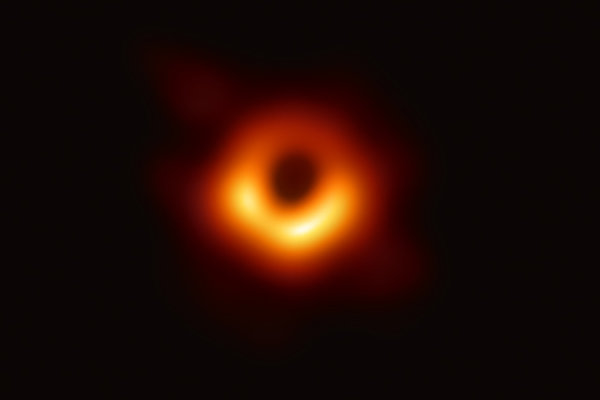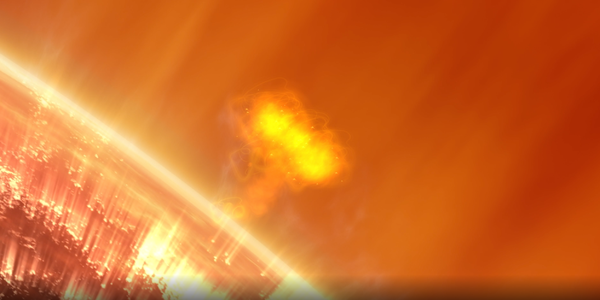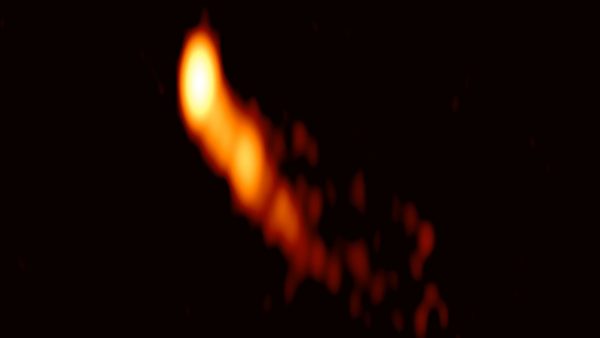Astronomers said Tuesday that they had for the first time seen a black hole spitting fire from the heart of a distant quasar. The work, by the same team that produced the first image of a black hole last year, illuminates the workings of one of the mysterious fountains of energy that dot deepest space and have tantalized astronomers with their ferocious energies ever since they were discovered more than 50 years ago.
Resolved in stunning detail from a distance of five billion light-years, this blowtorch of the gods appears as a bent flame 60 light-years long, shooting downward in the movie above from a bright central blob of unholy energy that might be the black hole itself.
The image was obtained using data from the Event Horizon Telescope, a globe-girdling network of radio telescopes. A year ago the Event Horizon collaboration thrilled the world by producing the first image of a black hole — a chute into eternity fringed by a fiery doughnut of doom at the center of the giant galaxy Messier 87 in Virgo, one of the great belching cosmic monsters. Using a technique called very long baseline interferometry, the telescope achieves the resolving power of a telescope as big as the Earth.
The new work, led by Jae-Young Kim of the Max Planck Institute for Radio Astronomy, was published in the journal Astronomy and Astrophysics. He and his colleagues said their new images, based on observations completed in April 2017, would shed additional light on how such beasts marshal their energies and light up the universe.
Quasars have tantalized and tortured astronomers since they were discovered in the early 1960s as dots of light far, far away pouring out baffling amounts of energy into space. Gradually, a model of quasars and energetic galactic nuclei has evolved: Supermassive black holes, feeding on interstellar gas, dust and anything else that comes near, become surrounded by disks of doomed gas. These accretion disks then squeeze energy and particles out their poles like toothpaste from a tube, at nearly the speed of light.
This scenario was brilliantly affirmed a year ago when the Event Horizon Telescope was able to see the accretion disk around the M87 black hole, framing a cosmic pothole in space. That galaxy also has a long jet shooting from its black hole. But Earth is about 50 million light-years from the galaxy, too close to be able to take in the jet, said Sheperd Doeleman of the Harvard-Smithsonian Center for Astrophysics who is director of the Event Horizon Telescope collaboration.

How They Took the First Picture of a Black Hole
A planet-sized network of radio telescopes has assembled the first image of a black hole.
The galaxy in the new study, 3C 279, is five billion light-years away. Also in the direction of Virgo, it is thought to be powered by a black hole about 800 million times more massive than the sun.
Dr. Doeleman’s team observed the quasar for four nights in April 2017 as they were calibrating their telescope to get ready for M87. The fact that they saw the jet gave them confidence that their imaging software worked. So, as he said in an email, they had seen that jet before, “just not in this detail, and the results indicate a violent environment.”
Dr. Kim’s group has now reprocessed the observations from those four nights. In addition the group used two other sets of radio telescopes at different frequencies and different resolutions on other days. They did this to study the structure of the quasar’s jet and zoom in on its source, like opening a set of Matryoshka dolls, in Dr. Kim’s words.
The results can be seen in the movie above. As viewed from afar at the lowest magnification, the jet bends down from a bright spot at the top of the frame, which corresponds to the center of the quasar, where the black hole is presumably working its grinding magic. Seen closer up, the jet decomposes into a series of blobs or hot spots shooting out. They form a line that bends slightly.
Under the highest magnification, the viewer is left with two blobs — one at the top of the image, which is source of the jet, and the lower feature, which is one of the jet’s outbursts of energy. The source of the jet looks like a bar turned sideways, nearly perpendicular to the direction of the blowtorch.
That, Dr. Kim said in a statement, was a surprise, because they found this unexpected, perpendicular form where they expected to find only the source of the jet.
“This is like finding a very different shape by opening the smallest Matryoshka doll,” he said.
The perpendicular structure, the astronomers said in their paper, could be the accretion disk itself, the doughnut of fiery doomed material that circles the black hole. Enormous pressures and magnetic fields in that realm squeeze energy out the top and bottom of the doughnut at nearly the speed of light.
Dr. Doleman ventured, however, that it could just be the beam twisting again to make life difficult for the observers.
In the second half of the movie, the astronomers compared images from the Event Horizon Telescope at a single wavelength over the course of a week to see how the knots in the jet were moving.
They in fact appeared to be moving almost 20 times the speed of light, an optical illusion that results from the foreshortened angle from which we see the jet, Dr. Doeleman explained.
Another aspect of the magic of quasars.
“This shows the E.H.T. can be used to study a wide range of phenomena,” he said. “This time more of an incremental advance, sharpening our view of a powerful quasar.”

Sync your calendar with the solar system
Never miss an eclipse, a meteor shower, a rocket launch or any other astronomical and space event that’s out of this world.








